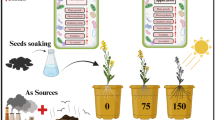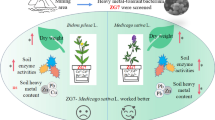Abstract
In order to investigate the effects of different soil Ni contents on the performances of fragrant rice seedlings, the present study conducted a pot experiment and adopted five soil Ni content treatments, i.e., 0 (CK), 50 (Ni50), 100 (Ni100), 200 (Ni200), and 400 (Ni400) mg kg−1. The fragrant rice seedlings were planted in these soils with different Ni contents. The results showed that there was no significant difference between CK and Ni50 treatment in growth parameters and biochemical indexes of seedlings. Compared with CK, Ni100, Ni200, and Ni400 treatments significantly decreased plant height, stem diameter, fresh weight, dry weight, and relative water content of seedlings. Lower net photosynthetic rates were recorded in Ni100, Ni200, and Ni400 treatment than CK. Compared with CK, Ni100, Ni200, and Ni400 treatments significantly reduced chlorophyll a, chlorophyll b, carotenoids, and total chlorophyll contents. The activities of peroxidase (POD), catalase (CAT), and superoxide dismutase (SOD) significantly reduced in Ni400 treatment compared with CK. Moreover, compared with CK, Ni200 and Ni400 treatment significantly increased H2O2, malondialdehyde (MDA), ascorbic acid (ASA) and glutathione (GSH), proline, and soluble sugar contents. Compared with CK, Ni200 and Ni400 treatments also enhanced nitrate reductase (NR) activity. In addition, Ni200 and Ni400 treatments significantly decreased the 2-acetyl-1-pyrroline (2-AP) content in fragrant rice seedlings. Our study would provide new information for the Ni-remediation of paddy soils and reducing Ni-induced effects on rice production.







Similar content being viewed by others
References
Afzal J, Saleem MH, Batool F, Elyamine AM, Rana MS, Shaheen A et al (2020) Role of ferrous sulfate (FeSO4) in resistance to cadmium stress in two rice (Oryza sativa L) genotypes. Biomolecules 10:1693
Ahmad P, Hashem A, Abd-Allah EF, Alqarawi AA, John R, Egamberdieva D et al (2015) Role of Trichoderma harzianum in mitigating NaCl stress in Indian mustard (Brassica juncea L) through antioxidative defense system. Front Plant Sci 6:868
Al Jabri H, Saleem MH, Rizwan M, Hussain I, Usman K, Alsafran M (2022) Zinc oxide nanoparticles and their biosynthesis: overview. Life (basel, Switzerland) 12:594
Alatawi A, Wang X, Maqbool A, Saleem MH, Usman K, Rizwan M et al (2022) S-Fertilizer (elemental sulfur) improves the phytoextraction of cadmium through Solanum nigrum L. Int J Environ Res Public Health 19:1655
Ashraf U, Kanu AS, Deng Q, Mo Z, Pan S, Tian H et al (2017) Lead (Pb) toxicity; physio-biochemical mechanisms, grain yield, quality, and pb distribution proportions in scented rice. Front Plant Sci 8:259
Bao G, Ashraf U, Wang C, He L, Wei X, Zheng A et al (2018) Molecular basis for increased 2-acetyl-1-pyrroline contents under alternate wetting and drying (AWD) conditions in fragrant rice. Plant Physiol Biochem 133:149–157
Behera B, Kancheti M, Raza MB, Shiv A, Mangal V, Rathod G et al (2022) Mechanistic insight on boron-mediated toxicity in plantvis-a-vis its mitigation strategies: a review. Int J Phytoremediation. https://doi.org/10.1080/15226514.2022.2049694
Devi R, Behera B, Raza MB, Mangal V, Altaf MA, Kumar R et al (2022) An insight into microbes mediated heavy metal detoxification in plants: a review. J Soil Sci Plant Nutr 22:914–936
Gajewska E, Skłodowska M (2008) Differential biochemical responses of wheat shoots and roots to nickel stress: antioxidative reactions and proline accumulation. Plant Growth Regul 54:179–188
Hale B, Gopalapillai Y, Pellegrino A, Jennett T, Kikkert J, Lau W et al (2017) Validation of site-specific soil Ni toxicity thresholds with independent ecotoxicity and biogeochemistry data for elevated soil Ni. Environ Pollut 231:165–172
He LX, Zheng AX, Du B, Luo HW, Lu RH, Du P et al (2019) Low-concentration sodium selenite applications improve oxidation resistance of filling-stage rice. Appl Ecol Environ Res 17:989–998
Huang Z, Xie W, Wang M, Liu X, Ashraf U, Qin D et al (2020) Response of rice genotypes with differential nitrate reductase-dependent NO synthesis to melatonin under ZnO nanoparticles’ (NPs) stress. Chemosphere 250:126337
Javed MT, Saleem MH, Aslam S, Rehman M, Iqbal N, Begum R et al (2020) Elucidating silicon-mediated distinct morpho-physio-biochemical attributes and organic acid exudation patterns of cadmium stressed Ajwain (Trachyspermum ammi L.). Plant Physiol Biochem 157:23–37
Kong L, Ashraf U, Cheng S, Rao G, Mo Z, Tian H et al (2017) Short-term water management at early filling stage improves early-season rice performance under high temperature stress in South China. Eur J Agron 90:117–126
Li L, Tian H, Zhang M, Fan P, Ashraf U, Liu H et al (2021) Deep placement of nitrogen fertilizer increases rice yield and nitrogen use efficiency with fewer greenhouse gas emissions in a mechanical direct-seeded cropping system. The Crop Journal 9:1386–1396
Luo H, Du B, He L, Zheng A, Pan S, Tang X (2019) Foliar application of sodium selenate induces regulation in yield formation, grain quality characters and 2-acetyl-1-pyrroline biosynthesis in fragrant rice. BMC Plant Biol 19:502
Luo HW, Xing PP, Liu JH, Lai RF, He LX, Zhang TT et al (2020) Application of ornithine-induced regulation in yield formation, grain quality and aroma of fragrant rice. Cereal Research Communications 48:485–492
Luo H, Duan M, Kong L, He L, Chen Y, Wang Z et al (2021) The regulatory mechanism of 2-acetyl-1-pyrroline biosynthesis in fragrant rice (Oryza sativa L) under different soil moisture contents. Front Plant Sci 12:772728
Macedo FG, Santos EF, Lavres J (2020) Agricultural crop influences availability of nickel in the rhizosphere; a study on base cation saturations. Ni Dosages and Crop Succession Rhizosphere 13:100182
Manceau A, Tommaseo C, Rihs S, Geoffroy N, Chateigner D, Schlegel M et al (2005) Natural speciation of Mn, Ni, and Zn at the micrometer scale in a clayey paddy soil using X-ray fluorescence, absorption, and diffraction. Geochim Cosmochim Acta 69:4007–4034
Mostofa MG, Rahman MM, Siddiqui MN, Fujita M, Tran LP (2020) Salicylic acid antagonizes selenium phytotoxicity in rice: selenium homeostasis, oxidative stress metabolism and methylglyoxal detoxification. J Hazard Mater 394:122572
Ncube B, Finnie JF, Van Staden J (2013) Dissecting the stress metabolic alterations in in vitro Cyrtanthus regenerants. Plant Physiol Biochem 65:102–110
Rao G, Ashraf U, Huang S, Cheng S, Abrar M, Mo Z et al (2018) Ultrasonic seed treatment improved physiological and yield traits of rice under lead toxicity. Environ Sci Pollut Res 25:33637–33644
Rizwan M, Imtiaz M, Dai Z, Mehmood S, Adeel M, Liu J et al (2017) Nickel stressed responses of rice in Ni subcellular distribution, antioxidant production, and osmolyte accumulation. Environ Sci Pollut Res 24:20587–20598
Rizwan M, Mostofa MG, Ahmad MZ, Imtiaz M, Mehmood S, Adeel M et al (2018) Nitric oxide induces rice tolerance to excessive nickel by regulating nickel uptake, reactive oxygen species detoxification and defense-related gene expression. Chemosphere 191:23–35
Saleem MH, Fahad S, Adnan M, Ali M, Rana MS, Kamran M et al (2020b) Foliar application of gibberellic acid endorsed phytoextraction of copper and alleviates oxidative stress in jute (Corchorus capsularis L.) plant grown in highly copper-contaminated soil of China. Environ Sci Pollut Res 27:37121–37133
Saleem MH, Fahad S, Khan SU, Din M, Ullah A, Sabagh AE et al (2020c) Copper-induced oxidative stress, initiation of antioxidants and phytoremediation potential of flax (Linum usitatissimum L.) seedlings grown under the mixing of two different soils of China. Environ Sci Pollut Res 27:5211–5221
Saleem MH, Wang X, Ali S, Zafar S, Nawaz M, Adnan M et al (2021) Interactive effects of gibberellic acid and NPK on morpho-physio-biochemical traits and organic acid exudation pattern in coriander (Coriandrum sativum L.) grown in soil artificially spiked with boron. Plant Physiol Biochem 167:884–900
Saleem MH, Ali S, Rehman M, Rana MS, Rizwan M, Kamran M et al (2020a) Influence of phosphorus on copper phytoextraction via modulating cellular organelles in two jute (Corchorus capsularis L) varieties grown in a copper mining soil of Hubei Province, China. Chemosphere 248:126032
Seregin IV, Kozhevnikova AD (2006) Physiological role of nickel and its toxic effects on higher plants. Russ J Plant Physiol 53:257–277
Siddiqui MH, Al-Whaibi MH, Basalah MO (2011) Interactive effect of calcium and gibberellin on nickel tolerance in relation to antioxidant systems in Triticum aestivum L. Protoplasma 248:503–511
Sirhindi G, Mir MA, Abd-Allah EF, Ahmad P, Gucel S (2016) Jasmonic acid modulates the physio-biochemical attributes, antioxidant enzyme activity, and gene expression in glycine max under nickel toxicity. Front Plant Sci 7:591
Sreekanth TVM, Nagajyothi PC, Lee KD, Prasad TNVK (2013) Occurrence, physiological responses and toxicity of nickel in plants. Int J Environ Sci Technol 10:1129–1140
Szabados L, Savouré A (2010) Proline: a multifunctional amino acid. Trends Plant Sci 15:89–97
Tariq F, Wang X, Saleem MH, Khan ZI, Ahmad K, Saleem Malik I et al (2021) Risk assessment of heavy metals in basmati rice: implications for public health. Sustainability 13:8513
Tateishi Y, Nakagawa T, Esaka M (2005) Osmotolerance and growth stimulation of transgenic tobacco cells accumulating free proline by silencing proline dehydrogenase expression with double-stranded RNA interference technique. Physiol Plant 125:224–234
Vaculík M, Kováč J, Fialová I, Fiala R, Jašková K, Luxová M (2021) Multiple effects of silicon on alleviation of nickel toxicity in young maize roots. J Hazard Mater 415:125570
Wang A, Wang L, Yi H, Zhao Z (2005) Research of determinat ion of glutamic acid by colorimetry. China Condiment, 50–52
Yilmaz DD, Parlak KU (2011) Nickel-induced changes in lipid peroxidation, antioxidative enzymes, and metal accumulation in Lemna Gibba. Int J Phytorem 13:805–817
Zaheer IE, Ali S, Saleem MH, Arslan Ashraf M, Ali Q, Abbas Z et al (2020a) Zinc-lysine supplementation mitigates oxidative stress in rapeseed (Brassica napus L) by preventing phytotoxicity of chromium when irrigated with Tannery wastewater. Plants 9:1145
Zaheer IE, Ali S, Saleem MH, Noor I, El-Esawi MA, Hayat K et al (2020b) Iron-lysine mediated alleviation of chromium toxicity in spinach (Spinacia oleracea L) plants in relation to morpho-physiological traits and iron uptake when irrigated with tannery wastewater. Sustainability 12:6690
Zhang G, Bown AW (1997) The rapid determination of gamma-aminobutyric acid. Phytochemistry (Oxford) 44:1007–1009
Acknowledgements
This study was supported by National Natural Science Foundation of China (31971843), The Technology System of Modern Agricultural Industry in Guangdong (2020KJ105) and Guangzhou Science and Technology Project (202103000075).
Author information
Authors and Affiliations
Contributions
XT designed the research; WS, PX, YC, and RL performed the experiments and collected the data; HL analyzed the data and wrote the manuscript. XT provided guidance during the experiment and manuscript writing. All authors have seen and approved the manuscript and its contents and are aware of the responsibilities connected to authorship.
Corresponding author
Ethics declarations
Conflict of Interest
The authors declare no competing interests.
Additional information
Handling Editor: Vijay Pratap Singh.
Publisher's Note
Springer Nature remains neutral with regard to jurisdictional claims in published maps and institutional affiliations.
Rights and permissions
Springer Nature or its licensor holds exclusive rights to this article under a publishing agreement with the author(s) or other rightsholder(s); author self-archiving of the accepted manuscript version of this article is solely governed by the terms of such publishing agreement and applicable law.
About this article
Cite this article
Luo, H., Huang, W., Xing, P. et al. Effects of Different Soil Nickel Contents on Growth, Photosynthesis, Antioxidant Responses, and 2-Acetyl-1-Pyrroline Content in Fragrant Rice Seedlings. J Plant Growth Regul 42, 2672–2682 (2023). https://doi.org/10.1007/s00344-022-10736-9
Received:
Accepted:
Published:
Issue Date:
DOI: https://doi.org/10.1007/s00344-022-10736-9




